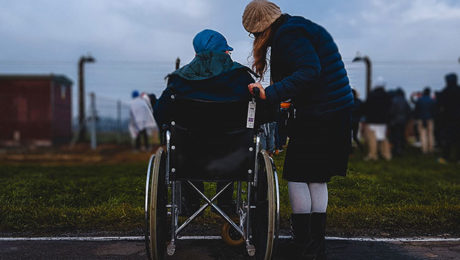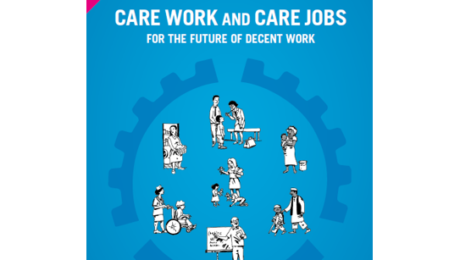LTC Sector Faces a Number of Challenges, Today and Going Forward: An OECD Report
OECD Health Policy Studies has released a 2020 report “Who Cares? Attracting and Retaining Care Workers for the Elderly.” This report addresses a number of important issues while acknowledging the tremendous impact that COVID 19 has had on elderly people and their caretakers. Across OECD countries, more than one out of every six individuals is above the age of 65, and of those roughly 60% live with multiple chronic conditions, making them even more susceptible to the potentially deadly impacts of the virus. Furthermore, many elderly individuals struggle with sufficient access to social support and lack the ability to properly deal with the mental strain of living in a world being affected by a global pandemic.
Beyond these strains, there is a crisis in workforce shortcomings of the Long Term Care (LTC) Sector, which becomes even more problematic in light of the fact that an estimated 50% of COVID 19 related deaths are occurring in LTC facilities. This OECD report begins by addressing many of these shortfalls within the LTC sector, and policies that have the potential to address them.
Within three-quarters of OECD countries, the aging population has outpaced the workforce within the sector since 2011. This is the case even in the countries that have a higher workforce supply than the OECD average such as Japan and the U.S. Within the sector, women make up 90% of the LTC workforce. Attracting a younger workforce has been particularly difficult, and on top of that maintaining workers over the age of 50 is also a challenge. This is even more concerning given that the median age of LTC workers is currently 45.
Many OECD nations have made moves toward relocating their elderly out of facilities and back into the community. This is provoked by the desire to match the preferences of their elderly populations with home-based care, in addition to containing LTC spending. However, a lack of home-based workers has made this challenging, and LTC institution-based workers remain representative of the sector’s workforce across the OECD. This is in large part due to the fact that these institutions cater to the most disabled, which requires a larger workforce. Furthermore, many community-based solutions are not yet equipped to take in these types of complex cases.
The aging of the postwar “baby boom” generation is a factor that will contribute to the increased need for LTC workforce. This also contributes to the predicted increase in labor shortages in the sector to meet the needs of this population going forward. Further, unpaid informal care workers, like that of family members that would care for this aging population, have seen an increase in their own professional workload burdens. When the workload of professional life and caretaking becomes too great, LTC facilities are a means in which to relieve some of that strain. Additionally, as birth rates decline, families become smaller and more women are pursuing professional endeavors, the availability of informal caregivers for the aging population decreases looking into the future. This contributes to another foreseen LTC workforce shortage in the future.

These shortages call for an increase in recruitment within the LTC sector. As the sector workforce ages, attracting younger workers has proven difficult as they, mostly women, are drawn to sectors that have a more appealing image such as a child or hospital care. Additionally, LTC jobs are still widely considered to be feminine positions, and the sentiment on this subject matter has been slow to change.
Foreign-born workers play a significant role in recruiting and retaining LTC workforce. They are highly over representative within LTC across the OECD when compared to other care sectors, and many of them are young, Often, they tend to come into the sector with high levels of skill sets, even overqualified. Micro-econometric analysis has shown that in the U.S. and the UK, these foreign-born workers have higher retention rates than others within the sector.
In terms of recruitment, drumming up interest in the available positions is also problematic. In some cases, many vacancies receive no applications at all. On top of this, recruiters often have a difficult time identifying qualified candidates out of those that do apply.
In order to address this, many countries have focused on four main policies:
– Target recruitment to the traditional pool
– Improve the Image of the sector
-Recruit outside the traditional pool
-Increase the recruitment of for foreign-born workers
Overall, better policies are needed in order to improve recruitment within the LTC sector, and thus far few OECD nations have implemented policies in order to do so. By addressing these issues addressed within the first section of this report, there is potential for effective improvement.
- Published in elderly care, Long Term Care Sector, Policy
Biden’s Care Plan Has the Potential to Change Care Work in the U.S. for the Better
Joe Biden has officially accepted the Democratic Presidential nomination, and he and his team plan to make substantial investments in the infrastructure of care in the U.S. if he wins in the Presidential election. The potential of this plan to provide much-needed support for care workers, both paid and unpaid, is more important than ever amidst the pandemic.
Even prior to this pandemic, the U.S. has long suffered a caregiving crisis. Family caregiving needs often come with incredible financial, emotional, and professional burdens. Professional caregivers, disproportionately women of color, have long been underpaid and undervalued. The pandemic has exacerbated these issues, leaving parents struggling to find the care services needed while juggling careers. There are a number of measures that have been proposed by the Biden team to address the many issues currently plaguing the overall care system in the U.S. today.
Elderly individuals in nursing homes are feeling an increasing need to be cared for at home rather than in community living situations where they are more vulnerable to COVID-19 exposure. The Biden care plan addresses this by aiming to close the existing Medicaid gap to allow for home and community-based care services while creating a state innovation fund for cost-effective direct care services. This will provide more affordable and accessible care on that front. This step will also help to alleviate the extensive waitlists now existing for those under Medicaid to enter home and community care programs, providing these services for 800,000 individuals. If implemented properly, this initiative allows the opportunity to provide more functional care systems that grant greater independence to elderly individuals, while also freeing many unpaid care workers, such as family members, to pursue professional endeavors.
This plan also proposes increasing wages and benefits for caregivers and early childhood educators while providing opportunities for training, professional growth, and unions. This particular initiative takes into consideration the fact that early childhood development is incredibly important, and quality childcare is essential for children to grow into healthy, productive members of society. Universal preschool will also be provided via tax credits and sliding scale programs. Furthermore, included is an investment into safe and developmentally appropriate childcare facilities, including bonus pay for those providers that operate non-traditional hours, such as early mornings, late evening, and weekends. By increasing access to childcare centers with more flexible hours, the burden for many families will be lifted; currently, many parents that don’t work traditional Monday through Friday hours are left scrambling to find adequate care. These initiatives overall will have significant positive impacts on working parents, particularly women. Far too often, women find themselves sacrificing professional progression and development due to the constraint of inadequate or unaffordable childcare.
For those parents who grapple with the decision to further their education as a result of unaffordable and reliable care, investment in childcare centers at community colleges is also included in this plan.
Lastly, expanding the awareness of the Department of Defense fee assistance childcare programs so that all military spouses have the ability to pursue their professional development and education.
In order to pay for these initiatives, the Biden team has estimated a cost of $775 billion over the span of ten years, to be funded by rolling back certain tax breaks for those earning over $400,000 annually. A $5000 tax credit or Social Security credits for those providing unpaid care for members of their family is also proposed. Further, the plan seeks to offer low- and middle-class families up to $8000 in tax credits to assist in paying for childcare. For those that choose not to claim this credit, high-quality care is to be provided on a sliding scale, where it is estimated that families will not pay over $45 per week.
Although this plan is incredibly ambitious, and its implementation is not a guarantee, it sets a precedent that has been long lacking within the U.S. care work sphere. Implementation of these initiatives on any scale would prove beneficial to both the paid and unpaid care economy.
This blog was authored by Jenn Brown, CWE-GAM Communications Assistant
- Published in Child Care, elderly care, Policy, U.S.
Digital Forum on Reopening Long Island and Building a Fair Economy:Care Work in the COVID Crisis
Earlier this month, the Hofstra Labor Studies and the Center for the Study of Labor and Democracy in collaboration with Long Island Jobs with Justice and A.L.L.O.W. (Advancing Local Leadership Opportunities for Women) conducted a virtual forum addressing care work in the context of COVID-19. This discussion emphasized the financial and mental health challenges associated with all types of care work during this pandemic, and the immense need to address and resolve these issues in order to assist with a fair and sustainable economic recovery. Although the discussion is focused primarily on Long Island and New York, the problems indicated are applicable to care work throughout the U.S.
There is anecdotal evidence to suggest that the unemployment or the stress of juggling work and home life as a result of the crisis has hit women much harder than men. This discussion utilized academia as an example of this, drawing upon data indicating that academic journal submissions have greatly increased among men since the beginning of the pandemic, but sharply decreased among women. For those working in academia, publishing work is crucial to professional advancement.
The pandemic has also shed a harsh light on the fragility of the overall childcare system in the U.S. Many families lacked adequate childcare even before the pandemic, forcing them to rely on unpaid care work. These existing issues paired with the recent closures of childcare facilities has exacerbated the problem.
Although the CARES Act did include childcare support, New York receiving $164 million going toward the childcare industry to provide protective equipment and cleaning supplies, the panel argues that while helpful those measures still did not provide adequate relief. The HEROES Act could potentially provide further relief for the care industry, but participants of this forum are less than optimistic about it providing the level relief needed.
The International Labor Organization estimates that three-quarters of unpaid care worldwide is provided by women. In the U.S. women provide 37% more unpaid care work than men on a daily basis. Among care providers in the U.S., Hispanic women do the majority of unpaid care and account for the biggest gap among men and women. Beyond traditional gender roles, this is largely tied to economics; oftentimes men have opportunities to make more money. But generally speaking, even when both parents work full time, women are still taking on more unpaid work even if they are earning more money than the male figure within the household.
There is also a societal tendency which expects care workers to be exceptionally giving. This is highlighted in the fact that even within paid care work positions, there is a fair amount of unpaid work being performed. For example, staying with an elderly person at their doctor’s appointment a couple of hours after the official workday has ended. This is a constant strain within the care industry, and COVID-19 has increased the pressure on this component of unpaid work within the paid care industry.
Additionally, the many racial and ethnic disparities within care work serve as a microcosm of larger racial inequities prevalent in society. For example, in New York, 80% of care workers are women, and a large majority of them are women of color. Furthermore, care workers in New York typically make minimum wage yet are still known to go above and beyond in their roles to ensure the best care is provided, regardless of whether or not it is part of their job description. This existing issue has been pushed to a new level due to COVID-19; now many of our care workers are putting their lives on the line.
Part of the reason that low wages are prevalent within the care sector is the historical association that care work is a “women’s job,” coming naturally and requiring little skillset. This sentiment in the U.S. is compounded by care work being viewed as the responsibility of the individual. The decision to have a family is viewed as a personal choice, therefore the basic needs of childcare are the sole responsibility of the parents, not something to be addressed via larger social safety nets.
New York is facing a particularly troubling dilemma within its care work industry. Despite the fact that a large majority of the workforce is comprised of immigrants, the guidelines that have been released outlining protection measures from COVID-19 are only available in English. This is concerning given that some workers may not yet possess the English language proficiency necessary to fully comprehend these guidelines.
In order to address these strains within the care work industry, political will and national policy are needed. The U.S. Department of Defense provides an exemplary model that could be emulated on a national scale. This government sector presently has one of the best childcare systems available in the U.S., operating on a sliding scale making it accessible to all those within the department that need it. This allows these federal employees to perform their duties with the comfort of this social safety net.
Furthermore, at the local level, immediate state, and county-level funding for care work can have a significant impact on the accessibility needed during this stressful time. Without swift action on the policy level, the issues discussed will continue and have detrimental effects on not only families, but economic recovery as well.
This blog was authored by Jenn Brown, CWE-GAM Communications Assistant
- Published in COVID 19, Expert Dialogues & Forums, Policy, U.S.
The True Cost of Caregiving: An Aspen Institute Digital Discussion
Even in a typical year, U.S. households are estimated to experience $31.9 billion in lost wages as a result of inadequate childcare and paid leave. Roughly 1 in 5 people living in the U.S. today incur caregiving expenses, and the need for care work is experienced in nearly every household at least once. Those who are professional care workers, disproportionately women of color, are underpaid and therefore susceptible to financial insecurity. Those insecurities have been exacerbated even further amidst COVID-19 and the resulting economic downturn.
In June 2020, the Aspen Institute Business and Society Program hosted a digital discussion “Paid Leave, Livable Wage, Affordable Care: Policies that Could Avert the Next Crisis” in conjunction a policy brief “The True Cost of Caregiving” that was released in May. Within this discussion, the panel focused on the fragility of the care system and the financial stability of those providing care, both paid and unpaid. The panel not only addresses these issues but seeks to re-imagine a system in which care is treated like a public good, examines the hierarchy of human value, delves into the historical context behind care work in the U.S., the vulnerability of care workers in the current pandemic, and the inefficiency of the current care economy within the larger economic system.
A number of important questioned are addressed such as:
– How to quantify the benefits of paid leave, livable wages, and affordable care policies?
-What are feasible policy responses to COVID-19, in both the short term and long term, that can lead to better systems of caregiving in the U.S?
-What does an inclusive and equitable care system could look like?
-Who bears responsibility for building this system?
Further, this panel brings to the table the idea that care work should be invested in collectively as a nation, as opposed to being looked at as an individual burden; which puts increasing downward pressure on those who are already disadvantaged in the U.S. due to race and gender.
Policies that address these concerns could assist in not only building a more equitable system of care but have the potential to aid in averting future crises like that which the care economy finds itself in today.
- Published in Child Care, Expert Dialogues & Forums, Policy, U.S.
“Being at Home” is Not Free – Making Informal Care Provision Visible and Providing Support During the Pandemic
The Japanese Government responded to the COVID 19 crisis by declaring a state of emergency and announcing an economic stimulus of 108 trillion yen, 6 trillion of which is allocated to households and small to midsized businesses. However, care work is not mentioned in this state of emergency. In the face of this pandemic, the government should be taking into account the increased burden of home care that is brought on in addition to the concerns regarding the collapse of medical care.
Although medical care is very important, home goes beyond medical care in terms of responsibilities. Take, for instance, an elderly person that has home aid providing essential forms of care – preparing meals, etc. These care workers are taking on huge risks and burdens, and the fact that neither policymakers nor the press are paying attention to this is problematic.
Additionally, as hospitals are overrun with the sickest patients, many those that have contracted COVID-19 are forced to stay home, leaving relatives, especially women, to care for them without the proper PPE or the vigorous sanitation needed. This will result in further spread of the virus, and each household will take on a similar pattern to what has been seen on cruise ships. Furthermore, in Japan, many people live in small homes, making it impossible to create “quarantined zones” within the home. There is also the consideration that many of those in isolation do not have a member of the household to do the shopping. Those individuals are left without access to basic provisions and this is especially the case amongst those that live alone.
Although Prime Minister Abe has thanked the medical staff and truck drivers, he has failed to mention the family care members and the important role they play, which might indicate that family care is seen as a mere obligation, as plentiful as water or air.
The government in South Korea has taken on a much different approach, taking note of these needs, it responded by providing provisions to those that are isolated at home and are unable to go shopping. These provisions show that publicly fulfilling care needs may help in preventing the spread of the disease.
Japan technically has similar measure in place under the Japanese Infectious Disease Control Law, which requires that the government must provide necessities in order to enable individuals to stay home to prevent the spread of infection. However, in actuality, this has not been the case. In Osaka, a modern welfare policy exists to provide coupons for residents for food delivery from local restaurants, helping both those in isolation and local small businesses. This is an example that could be replicated on a national scale with the cooperation of the government and private sector.
I created a survey with colleague Mr. Nanami Suziki to investigate the ease in which people can self-isolate. The survey was distributed through the internet in April 8th and as of April 12th , 330 responses were recorded. These results indicate that domestic work within the home is on the rise, with increasing burdens for those responsible for these tasks within the home. Furthermore, the increased domestic workload is putting strain on those who are remotely working from home.
Survey results show that although in many cases both men and women work remotely, women more often end up taking on all additional home responsibilities imposed by the pandemic, including homeschooling for the children.
As a result, many women are taking leave from their jobs, are working longer hours, and are becoming sleep deprived. Additionally, the increased family stress can lead to domestic violence. Policymakers and the press need to be more attentive to these increased burdens.
Steps can be taken to alleviate this situation, beginning with making care work visible and providing compensation. Further, ensuring employment and income those providing care for individuals in quarantine. This would follow the example set by South Korea in which those that cannot be paid to take leave can apply for living expenses to be supported through the government. As it stands now, Japanese relief policies fail to recognize the increased care burden being faced in the home, primarily by women.
Further, the government should respond by distributing lunch boxes to children that are not able to attend school due to closures, helping those children living in poor households that rely on school lunch. It is also important to support to the continuation of programs that are providing this sort of social care.
There have been some positive results from this situation, such as more family time and communication. Economy is only one aspect of life and moving forward, care work should be made visible in order to create a shift in society that mainstreams the value of “life” over “economy.”
* Thanks to Asahi Okamoto, Kaori Yamamoto, and Yoon Sodam.
This blog is authored by Emiko Ochiai who is a Professor of Sociology at Kyoto University.
Originally published in Japanese to the Women’s Action Network on Monday, April 13, 2020
- Published in COVID 19, Japan, Policy, South Korea
A Time for Reflection on Care
The world outside my study is churning and whirling… as it is engulfed with the fast-evolving health situations in communities around the globe. There are many unknowns about the
COVID-19 illness that has spread rapidly in every continent and the presence of uncertainty—big time—has rattled governments, shaken markets, and upended our daily routines, to say the least.
While I join the hundreds of millions of people who constantly check the news online and in newspapers, radio and/or tv, I also take time to pause. These moments allow me to reflect on
what this difficult time that we are all experiencing means and what it says about us—as
individuals, as members of communities, and as citizens of the world.
For one, I find that:
- each individual action has multitudes of rippling effects, large and small, on others;
- the real world oscillates between predictability and unpredictability; it requires each of us to constantly assess the balance between taking caution and taking risk;
- the distinction between self-interest and altruism (promoting others’ interests) becomes more blurred given the pervasive interconnectedness of our lives;
- adaptation and flexibility are vital life skills that we need to have not just now but at all times;
- we have the ability to change as we obtain more information and as conditions around us change; the notion of fixed tastes and preferences is outmoded;
- the skills that we must hone and develop should prepare us not only to live in a competitive world but also to be able to work together, coordinate and cooperate with one another; for the greater good requires collective action.
As the impacts of the COVID-19 spread intensify, there is growing recognition among governments and the public that traditional efforts for dealing with shocks and managing risks through conventional emergency responses are inadequate. Strategic thinking is needed as much as the ability to respond quickly and to take proactive measures. There is an urgent need to build the adaptive capacity and longer-term resilience of communities and societies.
One striking fact about the current global pandemic is its tremendous effect on the care sector. This includes not only the health care systems employing doctors, nurses, aides, and other health professionals but also the unpaid care labor provided by family members, neighbors, and kin.
Many are changing their daily life patterns to provide further assistance and care support for those who are vulnerable such as their parents or grandparents and for those who are self-quarantined. Many more are willing to take the risk of exposure to care for those who have tested positive and are ill but are staying at home because the healthcare system is inadequate, inaccessible, and/or overwhelmed. The shutdown of schools and daycare centers further adds demand for unpaid care. Parents are struggling to care for their children while at the same time trying to tele-work from home.
“How can I write or have meetings with my six-year old around?”
The cloak or mantle that hides the emerging crisis of social reproduction, or the under- provision of care for people who depend on it, is removed. This global pandemic exposes the heavy demand on those who carry the responsibility for providing care for the sick, the young and the frail elderly, the vast majority of whom have been women. It has upended preconceived notions such as: each individual is a ‘Robinson Crusoe’ in families that can find their own solutions to provide care, and that one’s ability to pay should determine who accesses care in the private sector.
The Care Work and the Economy Project joins the efforts of other organizations, research institutions and advocacy groups towards making the care sector visible to policymakers. The heavy care burden that is now being shouldered by health care systems, households, communities and countries throughout the world makes it imperative to bring care work out of statistical shadows and to remove the veil of ignorance in economic policymaking.
Let us hope that this time is truly different and that the jolt brought about by the current pandemic leads to more openness in the academic community and among policymakers towards a paradigm shift and policy change.
March 2020
- Published in Child Care, COVID 19, elderly care, Maria Floro, Policy
The Effects of Public Social Infrastructure and Gender Equality on Output and Employment: The case of South Korea
According to the Global Gender Gap Index of the World Economic Forum (2018), South Korea is one of the lowest ranked countries in the world in terms of “Economic Participation and Opportunity” (124th out of 149 countries) as of 2018. The Global Gender Gap Index also shows that South Korea ranks 88th in terms of female labor force participation and 121st in terms of gender wage equality for similar work. The average wages of women in South Korea are on average 36.7% lower than average male wages (as of 2012, own calculations based on World Klems (2014) database). These statistics reflect that there is a significant economic gender gap in South Korea despite the fact that the country is now classified as a high-income economy. Moreover, the underdeveloped care infrastructure and reliance on unpaid care labor of women is posing serious demographic and social sustainability challenges in an aging society.
Existing research on the effects of public spending show a stronger positive effect of public spending in social care and education on female employment as well as total employment compared to public investment in physical infrastructure (Antonopoulos et al., 2010; Ilkkaracan, Kim and Kaya, 2015; Ilkkaracan and Kim, 2018; De Henau et al., 2016; Onaran, Oyvat and Fotopoulou, 2019a). These employment effects have further effects on the economy and the wellbeing of the society, as microeconomic studies across the board attest that a larger share of women’s income compared to that of men’s, is spent to satisfy the needs of the household (Blumberg, 1991; Antonopoulos et al, 2010; Pahl, 2000) and a possible increase in their income leads to increased spending on children’s education and wellbeing (Vogler and Pahl, 1994; Lundeberg et al. 1997; Cappellini, Marilli and Parsons, 2014). Onaran, Oyvat and Fotopoulou (2019a) confirm this finding at the macroeconomic level for the case of the UK. These consequently have further demand and supply side effects on output, productivity and employment (Onaran, Oyvat and Fotopoulou, 2019a; Seguino, 2017).
Oyvat & Onaran (2019) examines the short-run and medium-run impact of public spending in social infrastructure, defined as expenditure in education, childcare, health and social care on aggregate output and employment of men and women for the case of South Korea. They present a gendered Post-Kaleckian theoretical macroeconomic model. The authors estimate the macroeconomic effects of social expenditure using a vector autoregression (VAR) analysis for the period of 1970-2012. The results show that an increase in the public social infrastructure significantly increases the total non-agricultural output and employment in South Korea both the short and medium-run. Moreover, higher social infrastructure expenditure increases female employment more than male employment in the short-run and raises both male and female employment in the medium-run due to increasing aggregate output. Finally, estimates show that the South Korean economy is wage-led and gender equality-led in the short-run, hence overall equality-led, although the effects are economically small in comparison to the strong effects of increases social infrastructure spending, and become insignificant in the medium-run. The results indicate that sustainable equitable development and a substantial increase in employment requires a mix of both labor market and fiscal policies.
This paper will be available December 2019
- Published in Gender-Aware Macromodels, Policy, Rethinking Macroeconomics, South Korea
Current Policies and Programs Addressing Childcare and Eldercare in South Korea
South Korea has experienced rapid economic growth and accelerated industrialization and modernization within a relatively short period of time in the seventies and eighties (Jang, 2009). Social policies were heavily oriented in supporting the government’s development strategies in terms of increasing human capital and improving health through public investment in these sectors (Song, 2014). Through most of that period, families were encouraged to carry the entire burden of care work and childrearing responsibilities, and social policies played a minimal role in sharing this burden, being mainly targeted to very limited low-income groups. Furthermore, filial piety, called hyo, one of the Confucian ideologies that served as a dominant foundation of state philosophy before the modern era of South Korea, remained even after the establishment of modern government and functioned as an essential foothold in determining care responsibility, unloading it entirely to the family (Lee, 2017).
However, demographic shifts, government regime change, and democratization process highlighted the need to address issues of redistribution and welfare and the important role of the state. The concept of the state serving as the main care provider is now gaining more attention, with its importance highly underlined in the current era of low fertility rates and an aging population in South Korea. In response to increased social awareness and demands, the South Korean government has shown efforts to revalue care work and reach a range of families’ needs.
The major care policies that South Korea currently has in place are:
- the Early Childhood Education and Care Policy,
- the Long-Term Care Insurance (LTCI) Program,
- the Maternity Protection Act, and
- welfare policies for the disabled.
Gilbert and Neil (1974) in their book Dimensions of Social Welfare Policy introduced the idea that social provision can be divided into several types; power, cash, vouchers, time, services, and opportunity. The order of each type represents the degree of freedom of choice; for example, cash represents more freedom of choice compared to services. South Korea’s social and family policies have shown preference for expanding government provided care services, rather than developing social provision in the form of time or cash benefits. However, after recovering from economic crisis (1997-1998) and welfare reform (1999-2001), the Korean government has assumed greater responsibility by legislating, financing, and providing welfare, particularly childcare and elderly care, in public sectors, community level/local government sectors and also supporting the private care market sector. Promoting more care services supported the creation of more jobs in the care sector and allowed unpaid caregivers/housewives to enter labor force as paid careworkers.
South Korea’s social policy has gone through dramatic reforms recently, with the government moving its focus beyond the expansion of existing services towards creating policies (in the form of parental/emergency care leave as well as vouchers and allowances), which provide not only services but also financial support to households who take care of dependent family members on their own.
Currently the basic model for childcare in South Korea is to provide government-supported daycare (9:00 am to 4:00 pm) and education for all children from the ages of 0-6 years. When the model was first introduced, there were several blind spots and families’ needs were not always met. For example, early morning and late-night care (i.e. after 5:00 pm) was not provided. Korean society is notorious for long workhours for employed individuals, and the model doesn’t allow many dual-earner parents to both remain in full-time employment or the model requires them to find additional, often costly, care services. Over the last few years off-hours (7:00 am to 10:00 pm) care services were created and expanded to meet these unmet care needs. In addition, to prevent sole-care burden (“독박육아”, dok-bak-yook-a) among those who raise children alone at home, community-based childcare services for unpaid caregivers (e.g. housewives) were developed by local government subsidies. The prime objective of this service was to create a space for sharing childcare information within the community; engaging in education and entertainment together; and for lessening the burden of care, through services like childcare centers and co-parenting cafés.
Although the government (both central and local) expanded social policy significantly and provided huge amounts of subsidies for these services, several policymakers and researchers point out that parents or caregivers still feel burdened with care for their children and a great proportion of the expenses are still paid by the users.. For most social services, middle-class families are not eligible or only receive partial benefits since these programs mainly target low income families.
Even though the government has expanded social welfare programs since 2000, this was not in effect to impact the fertility rate. Therefore, the service-based childcare model has brought about discussion and debate in South Korea, as people tend to recognize that public services cannot meet the various needs of every family in the country. For example, for child care services, there has been debate on whether or not it is good for young children to stay 7-10 hours in a daycare center. Some scholars have also argued that there is a need to support caring for children “at home” or providing services in a “home-like” environment (Lee and Kim. 2011).
South Korea is also facing a “parental rights movement”, with advocates promoting family time and quality time for caring for children. Providing “time” for parents is the solution they feel will help parents the most. To provide higher flexibility for dual-earner parents who at the same time want to take care of their children by themselves, the government has pushed for a full year paid parental leave program. This was designed to give additional leave to parents who get 90 days maternity leave (fully paid) if they give birth. Both employed mothers and fathers can use full year parental leave until one child gets to age 9, respectively. This leave program guarantees about 50% of personal monthly income (although there is a ceiling for the income compensation). Although this full year parental leave program started in early 2000, it had been rarely practiced, as employers and sometimes even employees were reluctant to use it. However, to boost the low fertility rate, the government is now pushing for parents with young children to actually use this program. This is done by subsidizing (relieving company tax, spending direct financial funds), both in public sectors and private companies. According to labor statistics (2017) only 34,898 mothers and 502 fathers used parental leave in the year 2009, while, in 2017, the number of parents using the leave almost doubled for mothers (78,080) and increased dramatically for fathers (12,043).
In addition to parental leave policies, a financial benefit (age 0-5 years) starting from July 2018 will be provided to families with young children, with the eligibility set by their income level.
Compared to childcare, eldercare provision in South Korea has a shorter history. In 2008, the issue of eldercare gained greater attention, due in large part to the rapid growth of the elderly population and increase in life expectancies. A state-supported model of eldercare was developed as a result. The primary eldercare provision comes from long-term care insurance (LTCI), which allows all elderly with care needs access to non-live-in domiciliary (e.g. home helper services) and community and institutional-based care services, delivered by public and/or private for- and not-for-profit service providers. Unfortunately, the LTCI covered only 7.5 percent of total elderly population (age 65+) in South Korea, according to 2016 statistics (retrieved; http://www.longtermcare.or.kr/npb), while in Japan the eligibility rate is 18.4% and 15.2% in Germany. Despite the low percentage of elderly reached, 2017 statistics show that available eldercare services (both in-home service and institutional- based service) are being used by eligible beneficiaries, 84% and 64% capacity rate. Those who are not eligible for the LTCI are able to access comparable elderly care services within the community-based elderly care providers, which are partly supported by public voucher service, but mostly the cost is paid by individual families (Oh 2014: 1166).
Unlike childcare provision, where not only services but also time and money are given to families with young children, the South Korean eldercare model focuses more narrowly on direct service provision. The LTCI sometimes financed a family member who cares for dependent elderly parents if the adult child acquires a certificate of qualification for in-home eldercare, which is very rare. This feature was introduced to support elderly care in rural areas where in-home care workers or facilities are scarce. Meanwhile, it was expanded, later on, to urban areas (Yoon, 2014) to encourage some unpaid family caregivers to obtain care certificates that enable them to take care of their own parents in a more professional settings and earn a small income. Recently, however, the government announced that they will cut down on such family allowances, which could cause a devastating situation for those family caregivers. In order to compensate their income loss, it will be necessary to get a second job as a care provider and care for other non-family members or seek part-time jobs.
In regard to out-of-pocket expenses, even those families who are eligible for the LTCI benefit are required to pay a copayment. Currently, LTCI covers about 80% for institutional care and 85% for in-home-based care (copayment 20% and 15% respectively). Adult children’s income, commonly from paid full time and part-time work, is needed for caring for their elderly parents, which might drain their time available to care for their parents. Moreover, last year in 2017, the Korean government raised the LTCI payment rate (insurance fee) as well as the copayment rate due to the wage increase for paid caregivers in the LTCI sector, which will likely reinforce the issues described above. Yet, the government announced that they will support low to middle income families by subsidizing the out-of-pocket cost.
In terms of providing leave for caring for dependent elderly, this is much more limited than cash allowance policies. Employed individuals could apply for leave (full 90 days) for a limited period to take care of their parents. However, family leave for eldercare is mostly unpaid, which is very different from parental leave that provides partial income. The low fertility rates among young couples in Korea encouraged policymakers to adopt family-friendly parental leave policies. Unfortunately, although demographic shifts in Korea are a concern (the country is the world’s fastest-aging developed economy), policymakers have not felt the same incentives and pressure to create comprehensive leave policies to enable families to take care of dependent elderly on their own.
As the preceding discussion demonstrates, developing care models in South Korea has been a continuous process, with the government creating policies in quick response to urgent issues and challenges of the time. Despite the expansion in social care provisioning there remains questions of their impact on care recipients and their families. We have little information on how families navigate through the public and private care provision and make decisions about caring for dependent children and elderly family members. The issue of how families choose among different care delivery arrangements and to what extent they are able to combine public provision with their own private resources (i.e. time and money) to meet care needs has not been addressed. To date, little is known on how paid caregivers and unpaid family members develop relationships and emotional bonds with care recipients (i.e. child or elderly), and the linkages between paid and unpaid care work.
We argue that, without a comprehensive framework and a strong view on care, welfare and development, care policies in South Korea have yet to achieve the requisite level of recognition and effective utilization. There is still room for improvement to better meet the needs of families and redistribute responsibilities of care between private households and the public.
This blog was authored by Seung-Eun Cha, Hyuna Moon & Eunhye Kang
References
Kang, Young Wook (2002). Historic Review on the Changes of Infant Rearing Policies. Korean Public Administration History Review 11: 293-332.
Choi, In-Duck. (2014). A Study on the co-payment and the effect of long-term care insurance utilization by income level and region type. Journal of Community Welfare. 48: 135-164.
Hwangbo, Young Ran. (2014). A Historical review of the infant and child care act: Based on the characteristic of the law and the law system. Journal for Early Childhood Education and Care 9(2): 125-146.
Jang, Kyung-sup (2009). Family, Life course, Politics and Economy: Compressed Modernity Seoul: Changbi.
Kim Eun-jeong and Lee Hye-suk. (2016.) Evaluation of the Impact of Child Care Subsidy Program. Korean Institute for Health and Social Affairs.
Lee Meejin. (2017). Change on the family structure and policy for elderly care. Social Welfare & Social Work, 219:20-28.
Lee Seungmie and Kim Seonmi. (2011). A Basic Study on Public Nanny Service Characteristics and Improvement Strategies. Family and Environment Research 49(4): 51-65
Na, J. and Moon, M. (2003). Integrating Policies and Systems for Early Childhood Education and Care: The Case of the Republic of Korea. Early Childhood and Family Policy Series.
Oh, Young-ran. (2014). “A Study to establish social safety net of Elderly LTCI : Implication from the community inclusive care in Japan. Critical Social Welfare Academy Conference Presentation Paper. October 2014. 1166-1185.
Peng, Ito. (2009). Paid Care Workers in the Republic of Korea. UNRISD Research report 4, New York, UNRISD.
Peng, Ito. (2011). The good, the bad and the confusing: The political economy of social care expansion in South Korea. Development and Change, 42(4), 905-923.
Song, Da-young. (2014). Socializing of Caring and Delay of the Welfare State in Korea, Journal of Korean Women’s Studies 30(4):119-152.
- Published in Policy, South Korea, Understanding and Measuring Care
Research Teams Awarded Funding to Produce Theoretical Gender-Aware Macromodels
The Care Work and Economy project has awarded five research teams funding to produce theoretical gender-aware macromodels that incorporate care in the development context. Each team contributes to one of two broad macroeconomic themes in terms that also account for care work and gender inequality: 1) growth and employment, and 2) social reproduction and structural change.
Care Work and the Economy is excited to advance our understanding of and ability to effectively model the links between care and standard economic variables and concerns by supporting the following teams and their research:
“Social Reproduction, Gender Inequality and Economic Growth” by Elissa Braunstein (Colorado State University) and Stephanie Seguino (University of Vermont)
Braunstein and Seguino develop an empirically tractable macroeconomic model of social reproduction and economic growth, with applications to the challenges of economic development. Their paper sheds light on the following questions: does care matter for long-term growth, how do its effects compare to standard growth regressors like investment and education, and does the extent of gender inequality in responsibility for care partly determine the magnitude of these relationships?
Elissa Braunstein is Professor in the Department of Economics at Colorado State University. In 2015-2017 Braunstein served as Senior Economist at the Division of Globalization and Development Strategies and Officer-in-Charge of the Economic Cooperation and Integration Among Developing Countries unit at the United Nations Conference on Trade and Development (UNCTAD). She has a Ph.D. in Economics from the University of Massachusetts Amherst, and a Master’s Degree in Pacific International Affairs from the University of California San Diego.
Stephanie Seguino is Professor in the Department of Economics at the University of Vermont. She has been an advisor or consultant to numerous international organizations including the World Bank, United Nations Development Program, the Asian Development Bank, and USAID, and publishes regularly in a number of economic journals, including World Development, Journal of Development Studies, and Feminist Economics. Dr. Seguino has also contributed her services to local and global living wage campaigns.
“Long-run Macroeconomics When People are not Exogenous: an overlapping generations approach to fertility, unpaid work, and economic growth” by James Heintz and Nancy Folbre (Political Economy Research Institute at the University of Massachusetts Amherst)
Heintz and Folbre produce an overlapping generations macro model in which production and investment are redefined to include the contribution of unpaid labor. The paper critically examines the standard macroeconomic definitions of income, production, investment, and savings and propose alternatives that take into account unpaid, non-market labor. It then develops a more realistic set of micro-foundations for macroeconomic modeling that incorporates bargaining power, the distribution of income/wealth, gender dynamics, and the costs of children; explore how transfer payments between men and women, between government and households, and between generations affect fertility choice, investments in children, and macroeconomic outcomes.
James Heintz is Associate Director of the Political Economy Research Institute (PERI) and Andrew Glyn Professor of Economics at the University of Massachusetts Amherst. Heintz holds a Ph.D. from the University of Massachusetts and a Master’s Degree from the University of Minnesota. He has written on a wide range of economic policy issues, including job creation, global labor standards, the distributive consequences of macroeconomic policies, and human rights. He has worked on collaborative projects with numerous United Nations agencies, including the International Labour Organization, the U.N. Research Institute for Social Development, the Economic Commission for Africa, the United Nations Development Programme, and UNIFEM.
Nancy Folbre is Director of the Program on Gender and Care Work at PERI and Professor Emerita of Economics at the University of Massachusetts Amherst. In 1998, she received the MacArthur Foundation genius grant award. Her research explores the interface between political economy and feminist theory, with a particular emphasis on the value of unpaid care work. In addition to numerous articles published in academic journals, she is the editor of For Love and Money: Care Work in the U.S. (Russell Sage, 2012), and the author of Greed, Lust, and Gender: A History of Economic Ideas (Oxford, 2009), Valuing Children: Rethinking the Economics of the Family (Harvard, 2008), and The Invisible Heart: Economics and Family Values (New Press, 2001).
“Financialization and the Care Economy” by Srinivas Raghav (NUI Galway) and Ramaa Vasudevan (Colorado State University)
Raghav and Vasudevan develop a macroeconomic model within the structuralist tradition to explore the linkages between financialization, household debt and unpaid care work. The team evaluates the implications of the growth of micro-credit and household debt under financialization for the care economy, as well as their repercussions for the wider macroeconomy.
Ramaa Vasudevan is Associate Professor in the Economics department at Colorado State University. Her Ph.D. in economics from New School University, New York, focused on the political economy of international trade and finance, while her M.Phil at the Centre for Development Studies, Trivandrum, India, was a study about the evolution of labor markets in colonial India. Her main research interests are in international finance, open economy macroeconomics and the political economy of development and finance.
Srinivasan Raghavendran is Lecturer in the Business and Economics department at NUI Galway. His research is focused on a number of major themes in the areas of Macroeconomics, Finance and Complex Systems, and Political Economy. The broad theme that connects various strands of his research is the issue of the dynamic interrelation between economic growth and distribution of income, and his current work focuses on this question in the context of financialisation. Dr. Raghavendra’s research is interdisciplinary. His research draws inspiration from the intellectual traditions of Michal Kalecki and John Maynard Keynes on the substantive front, and uses the methods and tools of Complex systems, to study the dynamics of growth and income distribution in the modern financial economies. Dr. Raghavendra’s research is underpinned by the principle that economic systems cannot be viewed independently of the wider socio-political context.
“Gendering Macroeconomic Analysis and Development Policy: The role of labour market and fiscal policies for gender equitable development” by Ozlem Onaran, Cem Oyvat and Eurydice Fotopoulou (University of Greenwich)
Onaran, Oyvat, and Fotopoulou develop a post-Keynesian, post-Kaleckian, feminist demand-led growth model to analyze the role of both labor market and fiscal policies in achieving gender equitable sustainable development.
Dr. Onaran is Professor of Economics at the University of Greenwich, UK and the director of the Greenwich Political Economy Research Centre. She has done extensive research on issues of inequality, wage-led growth, employment, globalization, gender, and crises. She has directed research projects for the International Labour Organisation, the Institute for New Economic Thinking, the Foundation of European Progressive Studies, the Vienna Chamber of Labour, the Austrian Science Foundation, and Unions21. She is member of the Policy Advisory Group of the Women’s Budget Group, the Scientific Committee of the Foundation of European Progressive Studies, and Scientific Advisory Board of Hans Boeckler Foundation. She has more than seventy articles in books and peer reviewed journals.
Dr. Cem Oyvat is Lecturer in Economics at the University of Greenwich. He received his Phd in Economics from University of Massachusetts – Amherst in 2014 with dissertation titled “Essays on the Evolution of Inequality”. His research interests include development economics, macroeconomics, international economics, income distribution and political economy.
Dr. Eurydice Fotopoulou is Lecturer in Economics at Goldsmiths, University of London. Eurydice’s research focuses on gender and macroeconomics, and in particular structular models that investigate income and wealth distribution inequality. She also works on the impact of labour market and fiscal policies. Her research is interdisciplinary, drawing from economics, sociology and gender studies. Recent collaborative research projects look into the effects of income, gender and wealth inequality, and economic policies on macroeconomic performance.
“Access to infrastructure, women’s time allocation and growth” by Pierre-Richard Agénor (University of Manchester) and Madina Agénor (Harvard University)
Agénor and Agénor develop a stylized model to explore and analyze access to infrastructure, women’s time allocation, and economic growth in developing countries. Pierre-Richard Agénor is Hallsworth Professor of International Macroeconomics and Development Economics at the University of Manchester. Prior to joining the University of Manchester, Professor Agénor was Lead Economist and Director of the Macroeconomics and Policy Assessment Skills Program at the World Bank.He also served as Senior Economist in the Research Department of the International Monetary Fund. During the academic year 2003-04, he was a Distinguished Visiting Scholar at Yale University.
Dr. Madina Agénor, ScD, MPH is an Assistant Professor of Social and Behavioral Sciences at Harvard T.H. Chan School of Public Health (HSPH). She holds a Doctor of Science (ScD) in Social and Behavioral Sciences from HSPH, a Master of Public Health (MPH) in Sociomedical Sciences from the Columbia University Mailman School of Public Health, and a Bachelor of Arts (AB) in Community Health and Gender Studies from Brown University. As a Postdoctoral Research Fellow in the Harvard Education Program in Cancer Prevention at HSPH and Dana-Farber Cancer Institute, she completed postdoctoral training in social epidemiology, cancer prevention and control, and LGBTQ health.
- Published in Policy
ILO Releases New Report on Care Work and Care Jobs
In June the International Labour Organization released their new report Care Work and Care Jobs for the Future of Decent Work. The report analyses the ways in which unpaid care work is recognized and organized, the extent and quality of care jobs and their impact on the well-being of individuals and society. A key focus of this report is the persistent gender inequalities in households and the labour market, which are inextricably linked with care work. These gender inequalities must be overcome to make care work decent and to ensure a future of decent work for both women and men.
The report contains a wealth of original data drawn from over 90 countries and details transformative policy measures in five main areas: care, macroeconomics, labour, social protection and migration. It also presents projections on the potential for decent care job creation offered by remedying current care work deficits and meeting the related targets of the Sustainable Development Goals.
Care Work and the Economy researcher Kijong Kim contributed a background study, co-authored with Ipek Ilkkaracan (Istanbul Technical University), entitled The Employment Generation Impact of Meeting SDG Targets in Early Childhood Care, Education, Health and Long-Term Care in 45 Countries.
- Published in Policy










